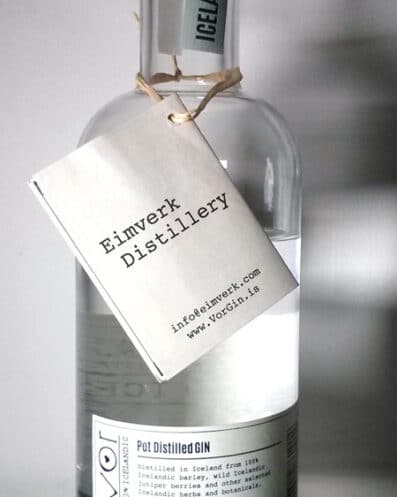Vor Gin is grounded in an idea. Terroir, the notion that place imbues the plants grown in a certain place with a unique character; or rather the idea that the climate that a plant experiences, the conditions of the soil, the time of the year, the sun, so and so forth, can alter that character of that which you grow in a certain place. This is backed up by innumerable chemistry journal articles which analyze the essential oil characteristics of such gin staples as angelica, juniper and coriander. For this piece we’ll call this terroir type I.
But a further more obvious aspect of terroir is often at play in gins such as Vor Gin. What grows around you natively is perhaps the most readily identifiable aspect of a place’s regional food culture. The same soil conditions that can cause juniper to contain different quantities of linalool also dictates why crowberry or a kind of moss grows in Iceland and nowhere else. And why you might not be able to grow Tapioca in a northern clime, or banana. For this piece we’ll call this terroir type II.
Vor gin is a gin which uses both affects to delirious effect. And it’s far from just a gimmick: the combination of the two creates a gin which is wholly like anything else out there.
Vor means spring in Icelandic. Let’s start with the base spirit. 100% pot-distilled organic barley. Barley lends a distinct character to the base spirit that is rich, and grainy all on its own. The notes of the base are immediately recognizable, but they do not stop there. Upon it they distill local juniper [terroir type I]. In addition they add local botanicals such as Crowberry [terroir type II, and more on this fruit below] and Iceland Moss [more type II and more on this again below]. In short, the combination of botanicals is unlike anything else you’ve ever seen in a gin, and you’re unlikely to have seen anywhere else before. That is unless you live in Iceland.
Where do we start? How about first with Crowberries.
Crowberries are native to the sub-arctic boreal regions around the world. The small purplish-black fruits are actually very low in aromatic oils [and flavors]; however, cooking is often used to heighten the flavor by boiling off of the water in them. Plants for a Future suggests that the fruits tastes best just after a frost*.
While once an important food for native peoples of the boreal regions, the Crowberry is again catching on as a jam/pie ingredient. The plants are “easy to grow,” and they’re often sold as creeping rock garden cover in local perennial plant stores in the United States. If you want to grow fruits, you’re going to need a male and a female, as the plant is dioecious.
But how can we stop there? We have Iceland Moss!
Firstly, we should get something straight. It’s technically a lichen. So how many gins have you had that have lichens in them?
But this plant has some peculiar characteristics that make it especially endemic to Iceland. It’s incredibly sensitive to pollution, so abandon all hope of growing this in your cities or towns. it’s been an important piece of local folk medicine tradition. Although it tastes bitter, it can be made into jellies or tonics. This folk medicine tradition might have some sort of bearing on reality. Scientists, according to Plants for a Future, have found that the plant contains compounds that are known antibiotics, which has made it a valuable ingredient in disinfectants. All of that, and I can easily say this among the most surprising ingredients I’ve seen in a gin, and unlike other gins which boast exotic ingredients for novelty sake, the Icelandic moss is so far down the list, that its included for its own merit, as if its own afterthought. Vor is a gin, not just a vehicle for showcasing Icelandic biodiversity. Now onto the taste.
Tasting Notes
Vor Gin is immediately recognizable for having a strong grain based base. Very grainy, with a bright pot distilled character. Lots of depth in the mids, with sweet floral notes that are myriad and complex. In trying to tease it out, you get herbal hints, licorice, sour berry, thyme, oregano, angelica, and a pinch of ginger. Wow. Very complex.
The palate of Vor Gin is oily and thick, with a rich viscous mouthfeel. Juniper, grain, strawberry rhubarb, licorice, oregano, rosemary and thyme. There’s a sage-like richness, fading gently into notes of spearmint, leading to a long licorice and juniper finish.Very robust, bursting with flavor. There’s a touch of heat on the palate, but only a subtle astringency. I mean, this is an incredible gin, at this taste alone. I’m really blown away by the flavor, the richness and complexity.
Sometimes I’m able to tease out readily identifiable notes and pick out each of the botanicals. But owing to my own naivete and lack of experience with some of these ingredients, I can’t tell you what the crowberry is adding, nor what the moss is doing. What I can say is that there’s a lot of notes in here, a lot of sensations and aromas that I can’t readily tie to an obvious botanical source. The thyme might be the most obvious note that I had on the nose and palate that readily corresponds to an ingredient. There’s an interesting Licorice note in here that I got on both the palate and nose, and I couldn’t place it among an obvious source. This gin is a challenge even for the experienced writer.
Cocktails
The first thing you notice is that your Gin and Tonic is cloudy. Vor Gin is not chill filtered; therefore the addition of water or other substances containing water will cause certain aromatic molecules to come out of solution and cloud the drink. This is called the Ouzo effect or a Louche. The flavor is bright spicy licorice and angelica, with sour lingonberry (!) in the mids. Finish is crisp and clean with mint notes, but also a dash of bitterness, with a vague citrus intimation and woody finish. Very nice and very complex. Highly Recommended.
Next I tried it in a Negroni. I was really impressed with this. Barley/grain character starts clearly, leading gently into the Campari dominated mid-notes with bitter myrtle orange, angelica, herbal hints of hops and sage. The finish is grain heavy again with a lingering note that calls to mind licorice again.
The Tom Collins was surprisingly bitter. The lemony sweetness seemed really held back, with instead of a complex sour and bitter notes with spice in the background.I had notes of unsweetened chocolate and bitter medicinal root. I was surprised by this, but overall this drink just didn’t work for me.
But this put me in a challenging place. Vor Gin didn’t work well in all cocktails. I really thought it was stellar in stronger, more bitter cocktails. it paired great with complex ingredients. It was a delicious co-star, but the Tom Collins just didn’t work right. But I don’t think that it took anything away from what it did right. Sometimes you love something and you just want to say “you don’t have to do it all, I love you just as you are.” Although it didn’t do everything right, I wouldn’t change a thing. This is a stellar gin, and one worth seeking out if you haven’t already.
Overall, Vor Gin
Rarely a gin comes along which is so complex and flavorful, with such depth and intrigue that you can cut it some slack for not working in a Tom Collins. It works everywhere else, and if this were more widely available, I’d probably always keep a bottle in stock in my home bar. Fans of heavier grain based gins or spice forward contemporary gins will love what they see here. Fans of the classic gin style might be surprised at first, but I believe if they give this gin a closer look they’ll find something here worth coming back to. Vor Gin, thus far is one of our favorites of 2014.


Wow–this rave review has certainly captured my attention! Any idea when/if it will be available in the states?
Excited by this gin! Unless I missed it, you didn’t suggest a tonic to pair with it. Any expert recommendations..?
I’d suggest something bright and clean: try 1724 Tonic Water if or Schweppes Indian Tonic [the UK/EU version, not the american bottled one] if you can get your hands on it. But when in doubt, if you can’t get the others roll with Fever Tree. Cheers!
Bought a bottle this morning as I passed through Iceland on business. I’m a traditionalist and like my gin neat with a small bit of ice. Looking forward to opening this one (as is my brother!) Hoping it’s as good as the review as am in Iceland 3 or 4 times a year on business
Available in our store in Belgium.
A friend was just passing through Iceland and picked up a bottle for me, which was delivered yesterday. I loved re-reading the review after having it last night in a G&T and neat. It is unlike any other gin I have ever tasted…it really is unique. I look forward to more “sipping” this evening.
Hey Josh, Vor Gin should be available by the end of this fall once we´ve cleared FDA approvals.
And thank you for a great review Aaron!
Egill
– Master Distiller
Eimverk Distillery
A friend just brought me a bottle from Iceland. Your review is spot on! The complexity is really incredible. This is not a typical gin by any means, but it is definitely something special. I would only drink it straight – why mess with it? Have a bottle of the Oak Rested Reserve as well – can’t wait to try it.
Aful, like moonshine with little Juniper tast. Hopefully better in the future.
I bought a bottle of this on the return from Iceland a few years back. An utterly unique flavour and one I adore. Skipped any mixer. With Vor, go straight! Niece is picking me up another bottle tomorrow on her way home. ❤️